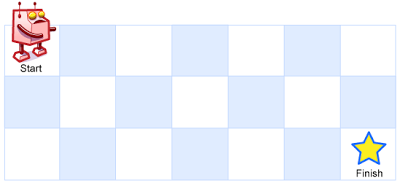A robot is located at the top-left corner of a m x n grid (marked 'Start' in the diagram below).
The robot can only move either down or right at any point in time. The robot is trying to reach the bottom-right corner of the grid (marked 'Finish' in the diagram below).
How many possible unique paths are there?
Example 1:
Input: m = 3, n = 7 Output: 28
Example 2:
Input: m = 3, n = 2 Output: 3 Explanation: From the top-left corner, there are a total of 3 ways to reach the bottom-right corner: 1. Right -> Down -> Down 2. Down -> Down -> Right 3. Down -> Right -> Down
Example 3:
Input: m = 7, n = 3 Output: 28
Example 4:
Input: m = 3, n = 3 Output: 6
Constraints:
1 <= m, n <= 100- It's guaranteed that the answer will be less than or equal to
2 * 109.
Dynamic programming.
class Solution:
def uniquePaths(self, m: int, n: int) -> int:
dp = [[1] * n for _ in range(m)]
for i in range(1, m):
for j in range(1, n):
dp[i][j] = dp[i - 1][j] + dp[i][j - 1]
return dp[-1][-1]class Solution {
public int uniquePaths(int m, int n) {
int[][] dp = new int[m][n];
for (int i = 0; i < m; ++i) {
Arrays.fill(dp[i], 1);
}
for (int i = 1; i < m; ++i) {
for (int j = 1; j < n; ++j) {
dp[i][j] = dp[i - 1][j] + dp[i][j - 1];
}
}
return dp[m - 1][n - 1];
}
}function uniquePaths(m: number, n: number): number {
let dp = Array.from({length: m}, v => new Array(n).fill(1));
for (let i = 1; i < m; ++i) {
for (let j = 1; j < n; ++j) {
dp[i][j] = dp[i - 1][j] + dp[i][j - 1];
}
}
return dp[m-1][n-1];
};class Solution {
public:
int uniquePaths(int m, int n) {
vector<vector<int>> dp(m, vector<int>(n, 1));
for (int i = 1; i < m; ++i)
{
for (int j = 1; j < n; ++j)
{
dp[i][j] = dp[i - 1][j] + dp[i][j - 1];
}
}
return dp[m - 1][n - 1];
}
};func uniquePaths(m int, n int) int {
dp := make([][]int, m)
for i := 0; i < m; i++ {
dp[i] = make([]int, n)
}
for i := 0; i < m; i++ {
for j := 0; j < n; j++ {
if i == 0 || j == 0 {
dp[i][j] = 1
} else {
dp[i][j] = dp[i-1][j] + dp[i][j-1]
}
}
}
return dp[m-1][n-1]
}
